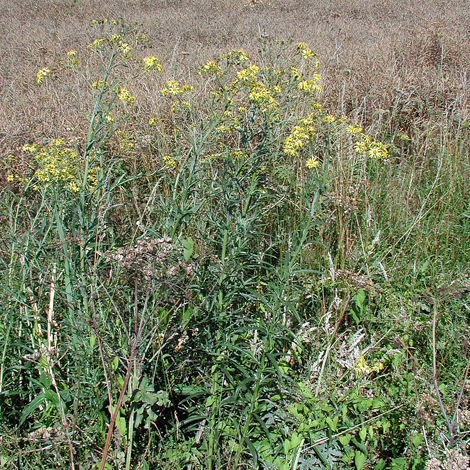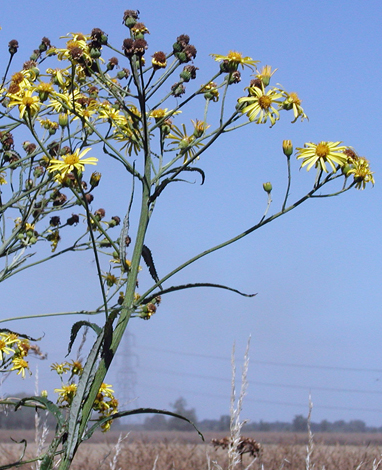Senecio paludosus Fen Ragwort RRR D N


This plant was growing unprotected in a ditch by a main road, although according to the wardens who showed me the plant it is thought to be the last naturally occurring plant in the country! It is taller than S. jacobaea (Common Ragwort) but the flowers not hugely dissimilar to S. aquaticus (Marsh ragwort).
The big difference between S. jacobaea and S. aquaticus and the very rare S. paludosus is the leaves which are linear or linear lanceolate and slightly serrate (toothed) and sessile (no leaf stalk or petiole) in S. paludosus. The leaves are more like S. sarracenicus (Broad-leaved Ragwort) in overall shape but much longer and narrower. The right hand photo shows the underside of one linear leaf.
Perhaps the problem for rare plants which a look a little like S. jacobaea is the horse fancying community. S. jacobaea is a liver poison for horses and the horsey enthusiasts will not only up root any they see but often demand that the owners of the land containing it do the same. They wouldn't think twice about digging it up and chucking on the rubbish tip believing that another S. jacobaea had met its end.
Would they seriously be bothered about the possibility of misidentification ? - probably not. It's only a yellow weed after all and there is little warning in their campaign literature that identification is fraught because of the number of similar looking Ragwort species which are native to the British Isles.
The interesting point about this concern with "dangerous" plants is that another group of naturalists have become very concerned about invasive non native plants species. They argue against such introductions and suggest we should attempt to get rid of the likes Impatiens glandifulifera, Crassula helmsii or Fallopia japonica from our conutryside and our gardens.
Extending this argument to the Senecio jacobaea versus The Horse perhaps we should campagn to get rid of the non native species: the horse.
The conservationists (another bunch of well meaning ecological meddlers) have re-introduced S. paludosus to suitable sites such as Wicken Fen where it would be protected from horse people but there lies yet another issue: should we really be re-introducing species which has died out?
Roadside, Breckland, 12th July 2003
Added on February 3rd 2005, updated April 3rd 2011,updated 6th Februaruy 2012



